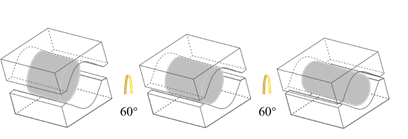
通过Deform-3D三维几何建模软件对烧结纯钼的多向锻造过程进行数值模拟,采用Pro-Engineering三维几何建模软件建立模型,采用绘图软件对流程进行描述得到模拟过程示意图。选择Langrangian增量形式计算锻造过程中的塑性变形。通过共轭梯度法计算单步,计算步之间采用直接迭代。锻造砧与锻件接触,设置相互间的库伦摩擦系数为0.3,锻造砧温度300 ℃,界面热传系数为5 N/(sec·mm·℃),环境温度为20 ℃,热对流系数为0.02 N/(sec·mm ℃)。多向锻造模拟过程中,通过不断调整各工步变形量和变形温度等参数,分别对立方坯体和圆柱坯体的纯钼多向锻造过程进行调整,经多次试验结果的优化对比,分析锻造过程中的应力应变场、温度场和致密度场等,得出最优选的锻造方案。采用真应变计算公式,通过锻件的尺寸,在前处理中对锻件温度、压下速率、压下方向等的设置,在后处理模块中可按照不同工步获得锻造后锻件的形状尺寸变化图;在网格分化模式下,可观察到软件计算模拟的金属网格图;在后处理模块中,通过选择不同切分位置,可获得多向锻造后锻件的等效应变分布、致密度分布及最大主应力分布。
The multi-directional forging process of sintered pure molybdenum was numerically simulated by Deform-3D three-dimensional geometric modeling software, the model was built using Pro-Engineering three-dimensional geometric modeling software, and the drawing software was used to describe the process to obtain a schematic diagram of the simulation process. The Langrangian incremental form is selected to calculate the plastic deformation during the forging process. A single step is calculated by the conjugate gradient method, and direct iteration is used between calculation steps. The forging anvil is in contact with the forging, the Coulomb friction coefficient between each other is set to 0.3, the forging anvil temperature is 300 ℃, the interface heat transfer coefficient is 5 N/(sec·mm·℃), the ambient temperature is 20 ℃, and the heat convection coefficient is 0.02 N /(sec·mm ℃). During the multi-directional forging simulation process, the pure molybdenum multi-directional forging process of the cubic blank and the cylindrical blank were adjusted by continuously adjusting the deformation amount and deformation temperature of each step and other parameters. After multiple test results, optimized comparison and analysis The stress and strain field, temperature field and density field in the forging process, etc., give the most optimal forging plan. Using the true strain calculation formula, through the size of the forging, setting the temperature, reduction rate, and reduction direction of the forging in the pre-processing, the post-processing module can obtain the shape and size change diagram of the forging after forging according to different steps; In the grid differentiation mode, you can observe the metal grid graph simulated by the software; in the post-processing module, by selecting different segmentation positions, the equivalent strain distribution, density distribution and maximum density distribution of the forging after multi-directional forging can be obtained. Principal stress distribution.